In Situ IR Study on Effect of Alkyl Chain Length between Amines on Its Stability against Acidic Gases
Abstract
1. Introduction
2. Results and Discussion
2.1. Characterization of the Adsorbents
2.2. Thermogravimetric Analysis
2.2.1. Degradation to CO2
2.2.2. Degradation to O2 and Acidic Gases
2.3. In Situ FT-IR Spectra of the Adsorbents
2.3.1. Degradation to CO2
2.3.2. Degradation to O2 and Acidic Gases
3. Materials and Methods
4. Conclusions
Author Contributions
Funding
Conflicts of Interest
References
- Li, K.; Jiang, J.; Yan, F.; Tian, S.; Chen, X. The influence of polyethyleneimine type and molecular weight on the CO2 capture performance of PEI-nano silica adsorbents. Appl. Energy 2014, 136, 750–755. [Google Scholar] [CrossRef]
- Oexmann, J.; Kather, A. Minimising the regeneration heat duty of post-combustion CO2 capture by wet chemical absorption: The misguided focus on low heat of absorption solvents. Int. J. Greenh. Gas Control. 2010, 4, 36–43. [Google Scholar] [CrossRef]
- Spigarelli, B.P.; Kawatra, S.K. Opportunities and challenges in carbon dioxide capture. J. CO2 Util. 2013, 1, 69–87. [Google Scholar] [CrossRef]
- Olajire, A.A. CO2 capture and separation technologies for end-of-pipe applications—A review. Energy 2010, 35, 2610–2628. [Google Scholar] [CrossRef]
- D’Alessandro, D.M.; Smit, B.; Long, J.R. Carbon dioxide capture: Prospects for new materials. Angew. Chem. Int. Ed. 2010, 49, 6058–6082. [Google Scholar] [CrossRef] [PubMed]
- Wu, X.; Yu, Y.; Qin, Z.; Zhang, Z. The advances of post-combustion CO2 capture with chemical solvents: Review and guidelines. Energy Procedia 2014, 63, 1339–1346. [Google Scholar] [CrossRef]
- Bonenfant, D.; Mimeault, M.; Hausler, R. Estimation of the CO2 Absorption Capacities in Aqueous 2-(2-Aminoethylamino) ethanol and Its Blends with MDEA and TEA in the Presence of SO2. Ind. Eng. Chem. Res. 2007, 46, 8968–8971. [Google Scholar] [CrossRef]
- Zhao, L.; Primabudi, E.; Stolten, D. Investigation of a Hybrid System for Post-Combustion Capture. Energy Procedia 2014, 63, 1756–1772. [Google Scholar] [CrossRef]
- Sanz-Pérez, E.S.; Olivares-Marín, M.; Arencibia, A.; Sanz, R.; Calleja, G.; Maroto-Valer, M.M. CO2 adsorption performance of amino-functionalized SBA-15 under post-combustion conditions. Int. J. Greenh. Gas Control. 2013, 17, 366–375. [Google Scholar] [CrossRef]
- Aroua, M.K.; Daud, W.M.A.W.; Yin, C.Y.; Yang, C.; Adinata, D. Adsorption capacities of carbon dioxide, oxygen, nitrogen and methane on carbon molecular basket derived from polyethyleneimine impregnation on microporous palm shell activated carbon. Sep. Purif. Technol. 2008, 62, 609–613. [Google Scholar] [CrossRef]
- Bezerra, D.P.; Oliveira, R.S.; Vieira, R.S.; Cavalcante, C.L.; Azevedo, D.C.S. Adsorption of CO2 on nitrogen-enriched activated carbon and zeolite 13X. Adsorption. 2011, 17, 235–246. [Google Scholar] [CrossRef]
- Choi, S.; Drese, J.H.; Jones, C.W. Adsorbent materials for carbon dioxide capture from large anthropogenic point sources. ChemSusChem 2009, 2, 796–854. [Google Scholar] [CrossRef] [PubMed]
- Bollini, P.; Didas, S.A.; Jones, C.W. Amine-oxide hybrid materials for acid gas separations. J. Mater. Chem. 2011, 21, 15100–15120. [Google Scholar] [CrossRef]
- Samanta, A.; Zhao, A.; Shimizu, G.K.H.; Sarkar, P.; Gupta, R. Post-combustion CO2 capture using solid sorbents: A review. Ind. Eng. Chem. Res. 2012, 51, 1438–1463. [Google Scholar] [CrossRef]
- Darunte, L.A.; Walton, K.S.; Sholl, D.S.; Jones, C.W. CO2 capture via adsorption in amine-functionalized sorbents. Curr. Opin. Chem. Eng. 2016, 12, 82–90. [Google Scholar] [CrossRef]
- Drage, T.C.; Arenillas, A.; Smith, K.M.; Snape, C.E. Thermal stability of polyethylenimine based carbon dioxide adsorbents and its influence on selection of regeneration strategies. Microporous Mesoporous Mater. 2008, 116, 504–512. [Google Scholar] [CrossRef]
- Heydari-Gorji, A.; Sayari, A. Thermal, oxidative, and CO2-induced degradation of supported polyethylenimine adsorbents. Ind. Eng. Chem. Res. 2012, 51, 6887–6894. [Google Scholar] [CrossRef]
- Bollini, P.; Choi, S.; Drese, J.H.; Jones, C.W. Oxidative degradation of aminosilica adsorbents relevant to postcombustion CO2 capture. Energy Fuels 2011, 25, 2416–2425. [Google Scholar] [CrossRef]
- Thompson, J.; Richburg, H.; Liu, K. Thermal Degradation Pathways of Aqueous Diamine CO2 Capture Solvents. Energy Procedia 2017, 114, 2030–2038. [Google Scholar] [CrossRef]
- Miller, D.D.; Chuang, S.S.C. Experimental and theoretical investigation of SO2 adsorption over the 1,3-phenylenediamine/SiO2 system. J. Phys. Chem. C 2015, 119, 6713–6727. [Google Scholar] [CrossRef]
- Choi, W.; Min, K.; Kim, C.; Ko, Y.S.; Jeon, J.W.; Seo, H.; Park, Y.K.; Choi, M. Epoxide-functionalization of polyethyleneimine for synthesis of stable carbon dioxide adsorbent in temperature swing adsorption. Nat. Commun. 2016, 7, 12640. [Google Scholar] [CrossRef] [PubMed]
- Pang, S.H.; Lee, L.C.; Sakwa-Novak, M.A.; Lively, R.P.; Jones, C.W. Design of Aminopolymer Structure to Enhance Performance and Stability of CO2 Sorbents: Poly(propylenimine) vs. Poly(ethylenimine). J. Am. Chem. Soc. 2017, 139, 3627–3630. [Google Scholar] [CrossRef] [PubMed]
- Lashaki, M.J.; Sayari, A. Stability of amine-functionalized CO2 adsorbents. Chem. Soc. Rev. 2019, 48, 3320–3405. [Google Scholar] [CrossRef]
- Kanan, S.M.; Tze, W.T.Y.; Tripp, C.P. Method to double the surface concentration and control the orientation of adsorbed (3-aminopropyl) dimethylethoxysilane on silica powders and glass slides. Langmuir 2002, 18, 6623–6627. [Google Scholar] [CrossRef]
- Howarter, J.A.; Youngblood, J.P. Optimization of silica silanization by 3-aminopropyltriethoxysilane. Langmuir 2006, 22, 11142–11147. [Google Scholar] [CrossRef] [PubMed]
- Ji, C.; Huang, X.; Li, L.; Xiao, F.; Zhao, N.; Wei, W. Pentaethylenehexamine-Loaded Hierarchically Porous Silica for CO2 Adsorption. Materials 2016, 9, 835. [Google Scholar] [CrossRef]
- Borkovec, M.; Koper, G.J.M. Ising models of polyprotic acids and bases. J. Phys. Chem. 1994, 98, 6038–6045. [Google Scholar] [CrossRef]
- Koper, G.J.M.; Van Genderen, M.H.P.; Elissen-Román, C.; Baars, M.W.P.L.; Meijer, E.W.; Borkovec, M. Protonation mechanism of poly (propylene imine) dendrimers and some associated oligo amines. J. Am. Chem. Soc. 1997, 119, 6512–6521. [Google Scholar] [CrossRef]
- Srikanth, C.S.; Chuang, S.S.C. Spectroscopic investigation into oxidative degradation of silica-supported amine sorbents for CO2 capture. ChemSusChem 2012, 5, 1435–1442. [Google Scholar] [CrossRef]
- Srikanth, C.S.; Chuang, S.S.C. Infrared study of strongly and weakly adsorbed CO2 on fresh and oxidatively degraded amine sorbents. J. Phys. Chem. C 2013, 117, 9196–9205. [Google Scholar] [CrossRef]
- Min, K.; Choi, W.; Kim, C.; Choi, M. Oxidation-stable amine-containing adsorbents for carbon dioxide capture. Nat. Commun. 2018, 9, 726–732. [Google Scholar] [CrossRef] [PubMed]
- Liu, H.; Namjoshi, O.A.; Rochelle, G.T. Oxidative degradation of amine solvents for CO2 capture. Energy Procedia 2014, 63, 1546–1557. [Google Scholar] [CrossRef]
- Lepaumier, H.; Picq, D.; Carrette, P.L. Degradation study of new solvents for CO2 capture in post-combustion. Energy Procedia 2009, 1, 893–900. [Google Scholar] [CrossRef]
- Lepaumier, H.; Martin, S.; Picq, D.; Delfort, B.; Carrette, P.-L. New Amines for CO2 Capture. III. Effect of Alkyl Chain Length between Amine Functions on Polyamines Degradation. Ind. Eng. Chem. Res. 2010, 49, 4553–4560. [Google Scholar] [CrossRef]
- Celedonio, J.M.; Pacia, R.M.; Ko, Y.S. Spectroscopic Study on Multicyclic and Long-time Stability of CO2 Adsorbent in Flue Gas Conditions. Catal. Today 2018, 303, 55–63. [Google Scholar] [CrossRef]
- Yu, K.; Mitch, W.A.; Dai, N. Nitrosamines and Nitramines in Amine-Based Carbon Dioxide Capture Systems: Fundamentals, Engineering Implications, and Knowledge Gaps. Environ. Sci. Technol. 2017, 51, 11522–11536. [Google Scholar] [CrossRef]
- Rezaei, F.; Jones, C.W. Stability of Supported Amine Adsorbents to SO2 and NOx in Postcombustion CO2 Capture. 2. Multicomponent Adsorption. Ind. Eng. Chem. Res. 2014, 53, 12103–12110. [Google Scholar] [CrossRef]
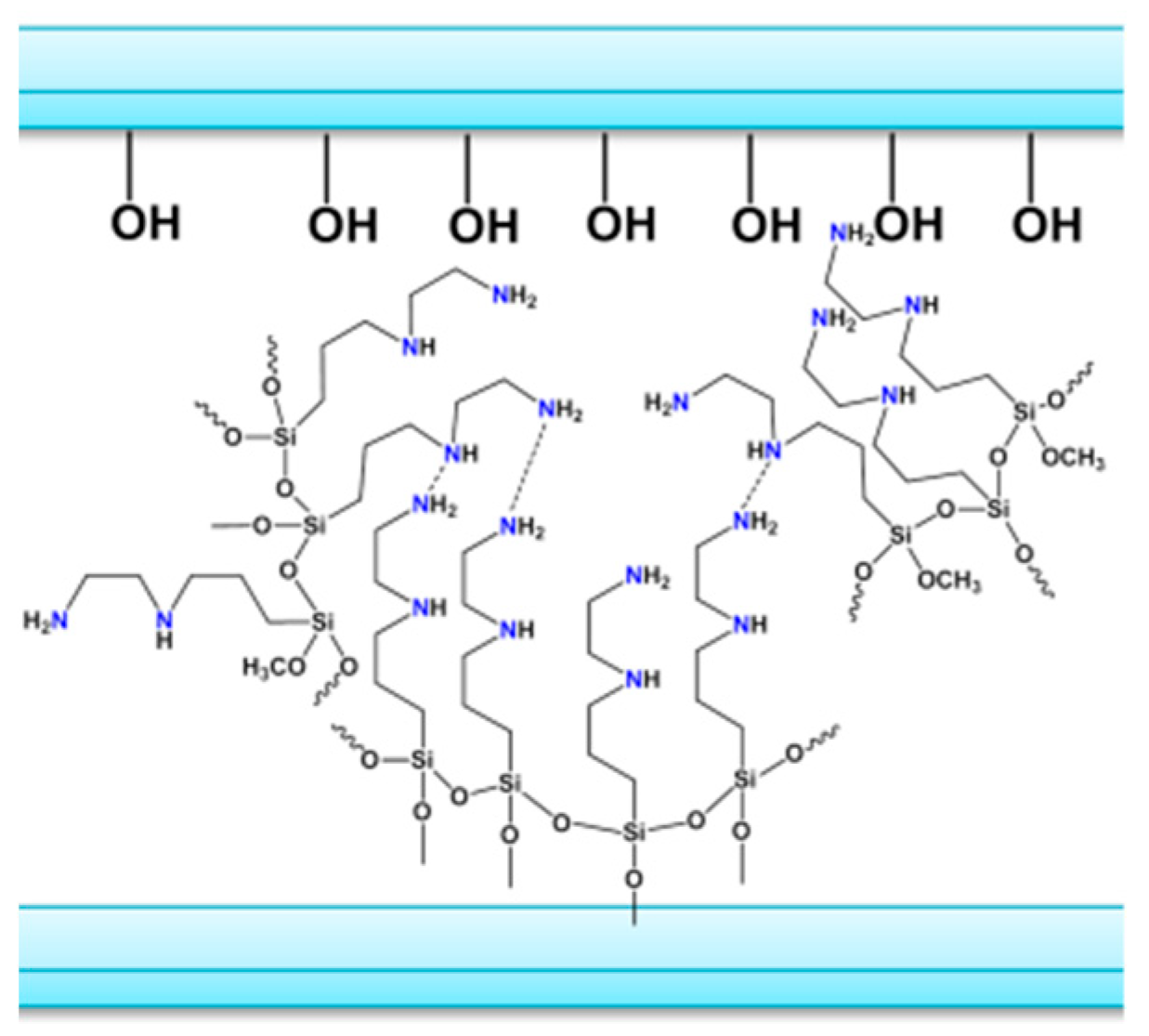
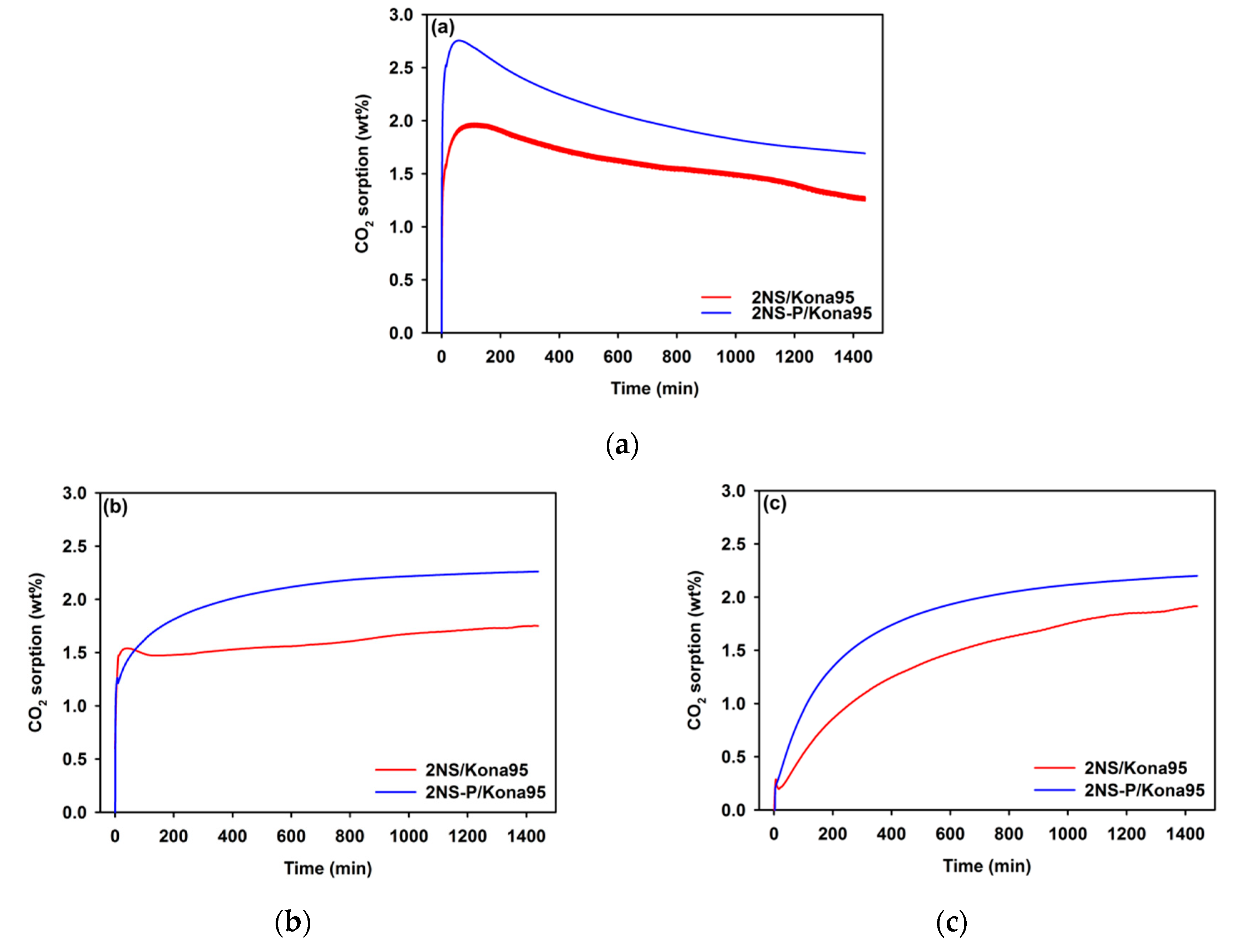
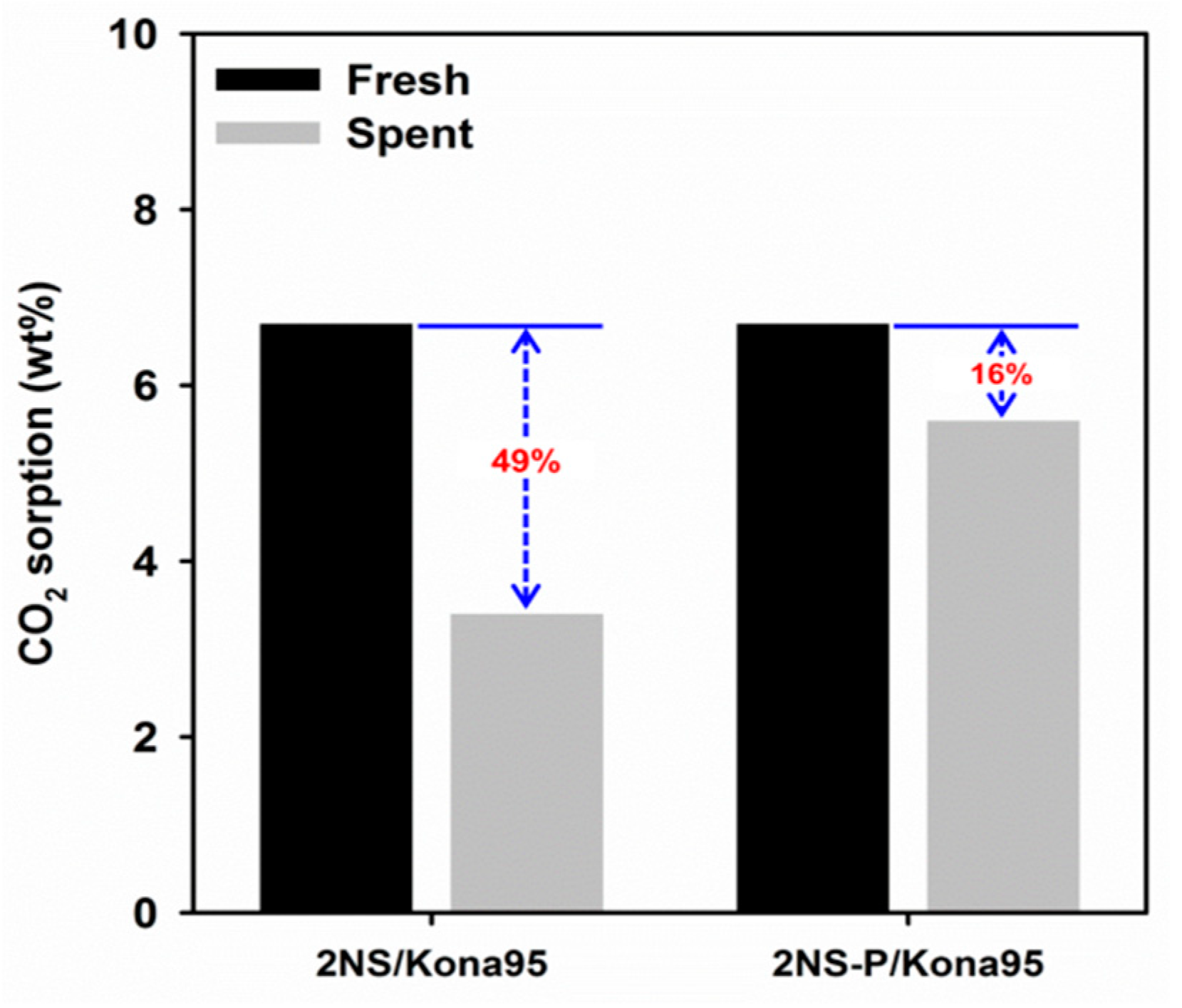
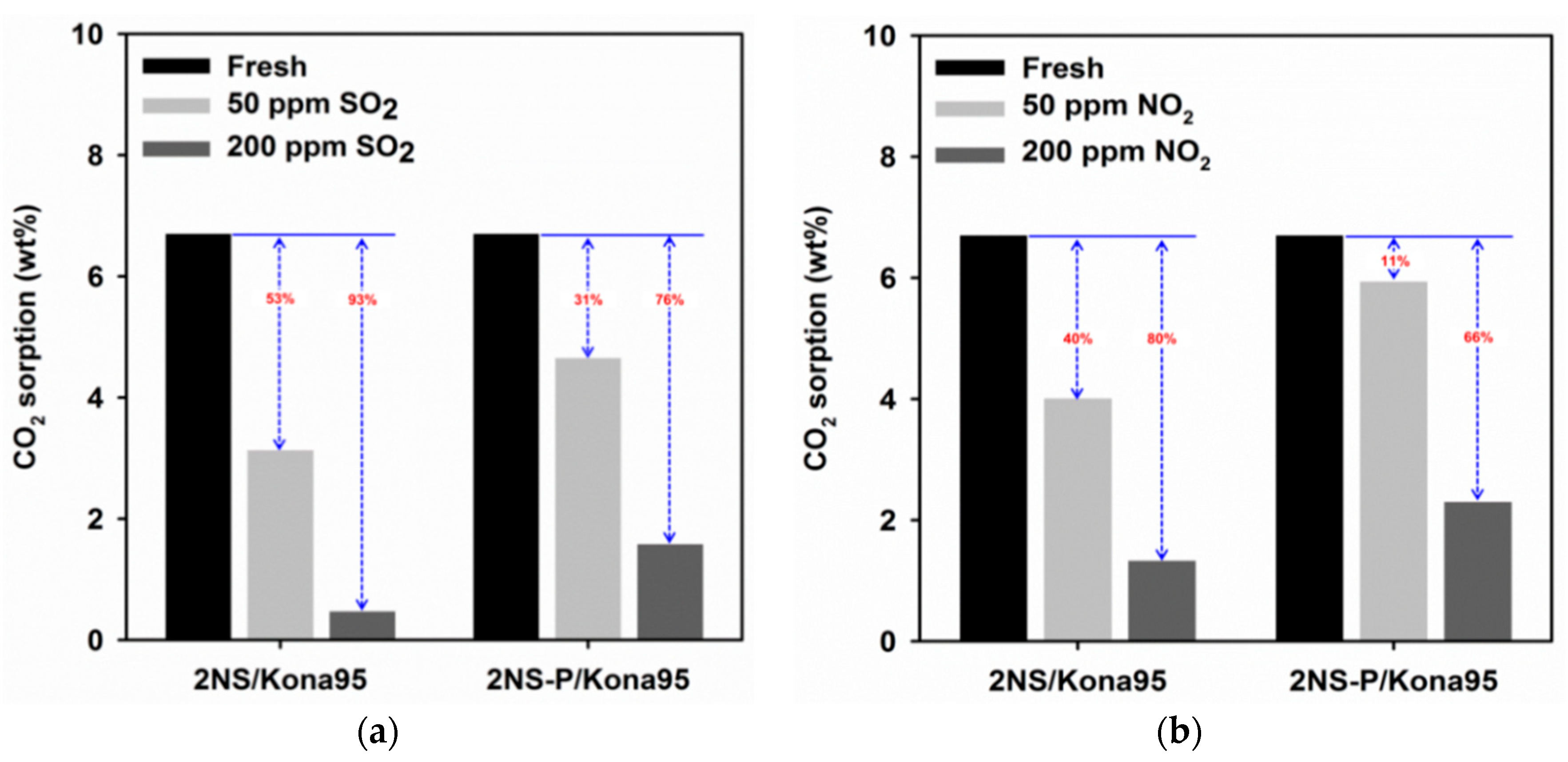
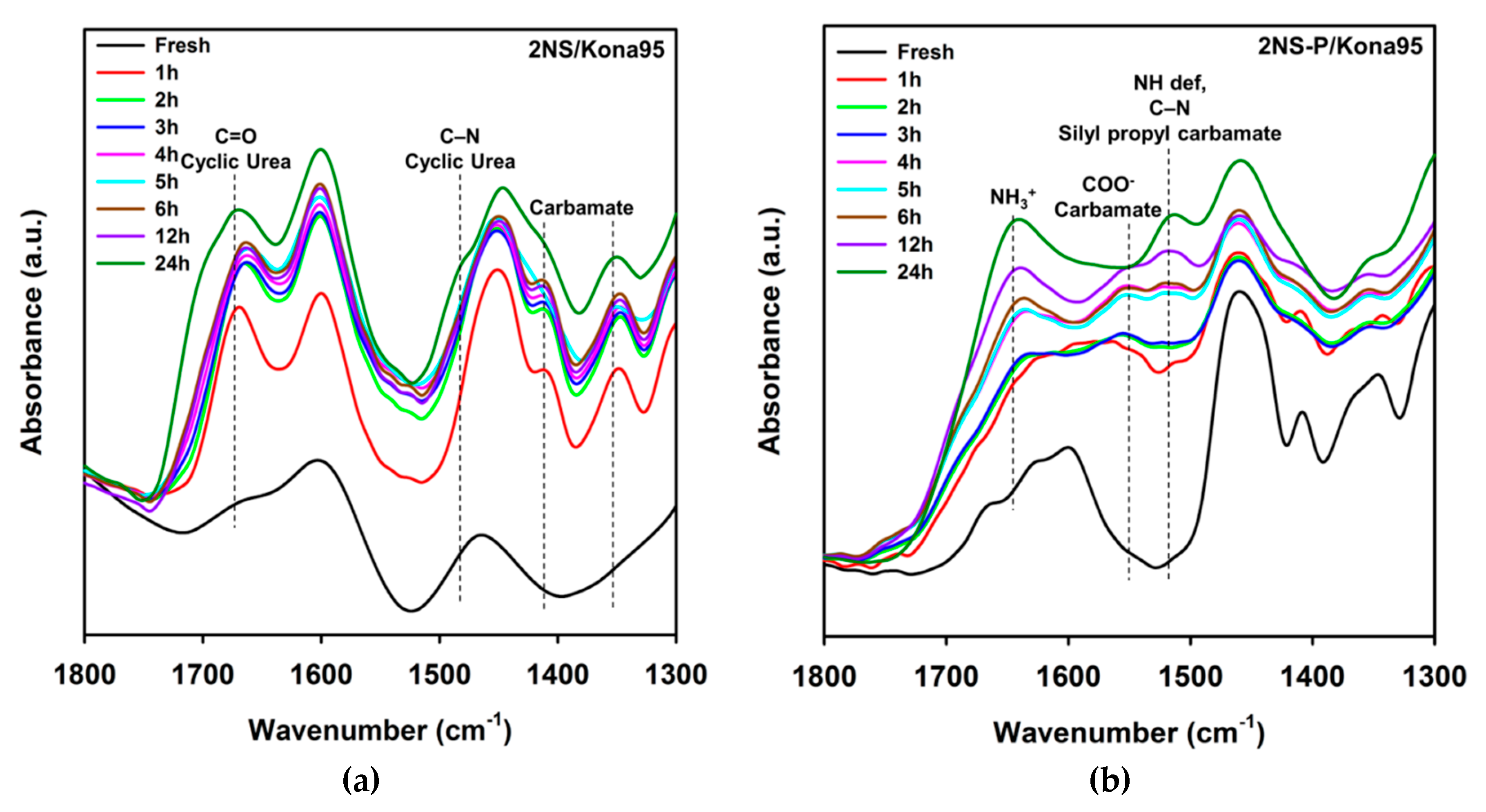
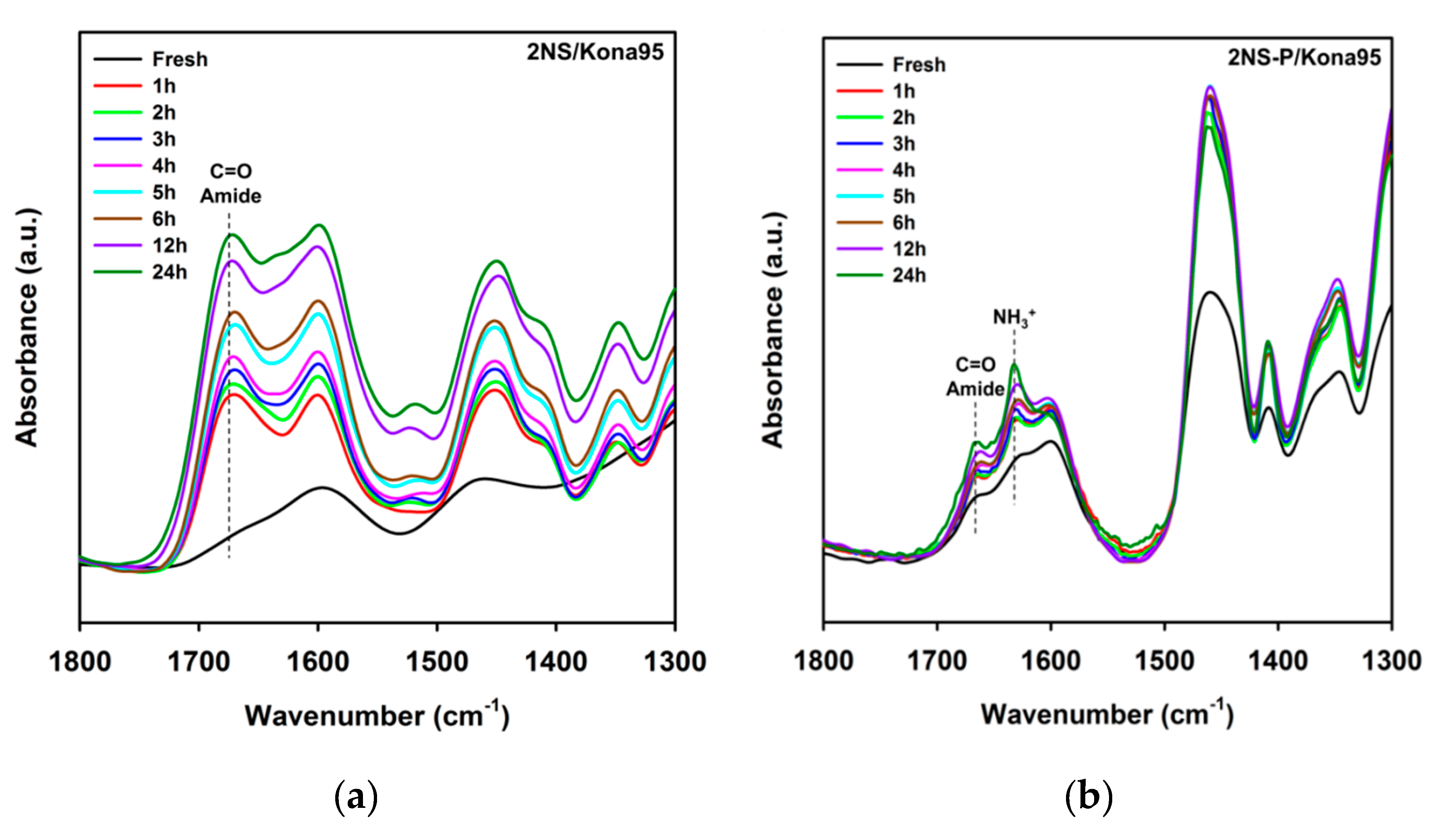
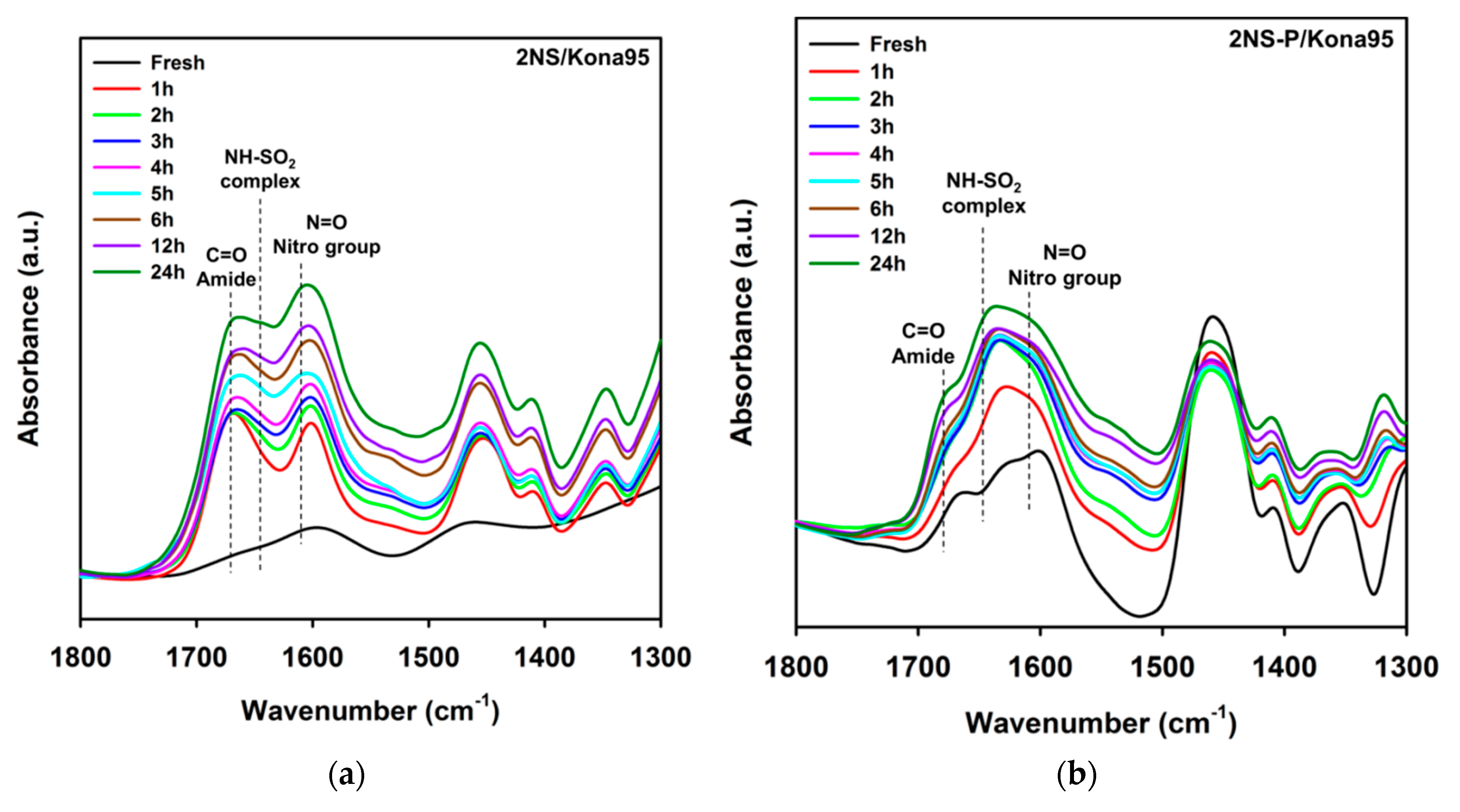
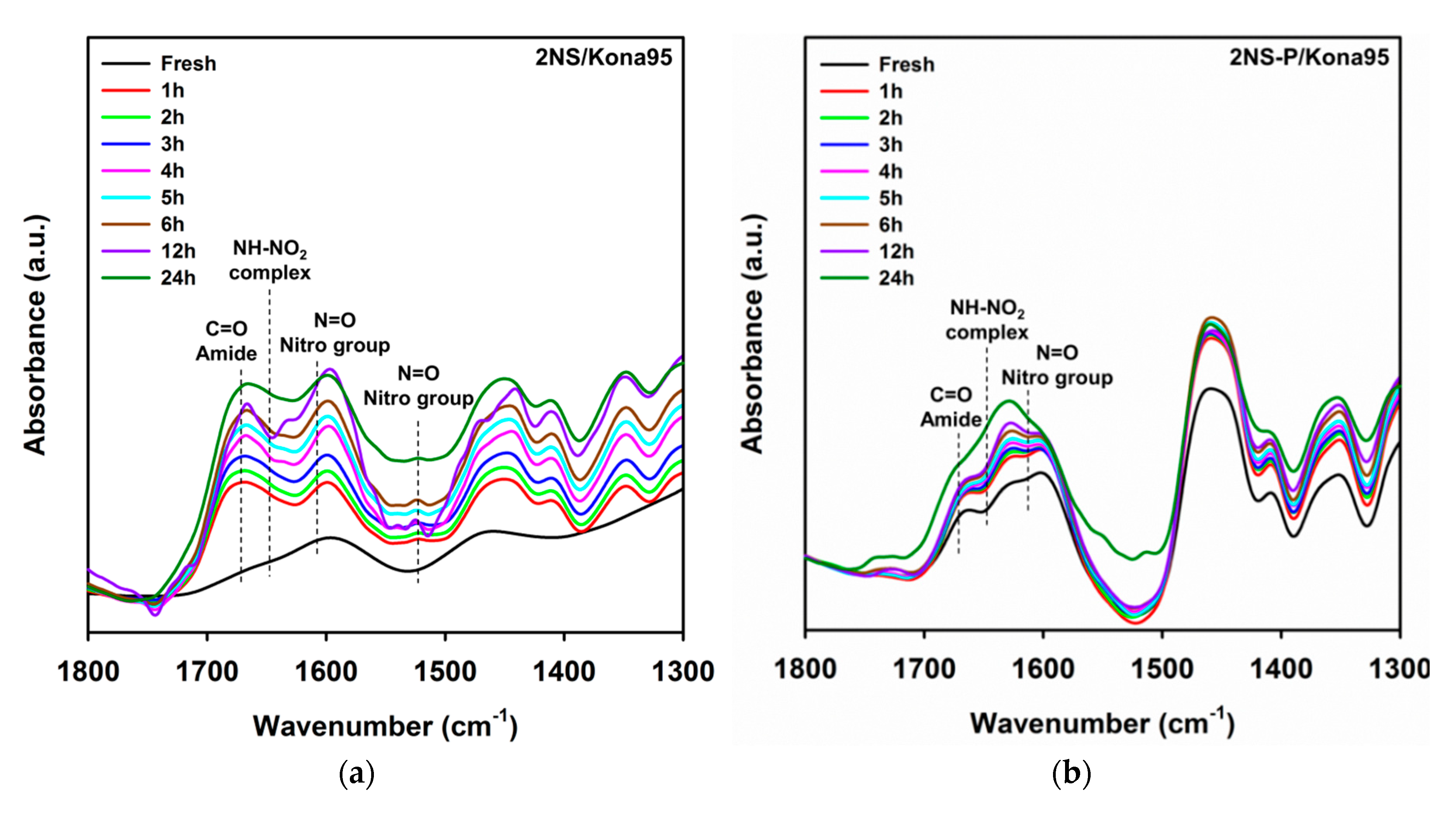
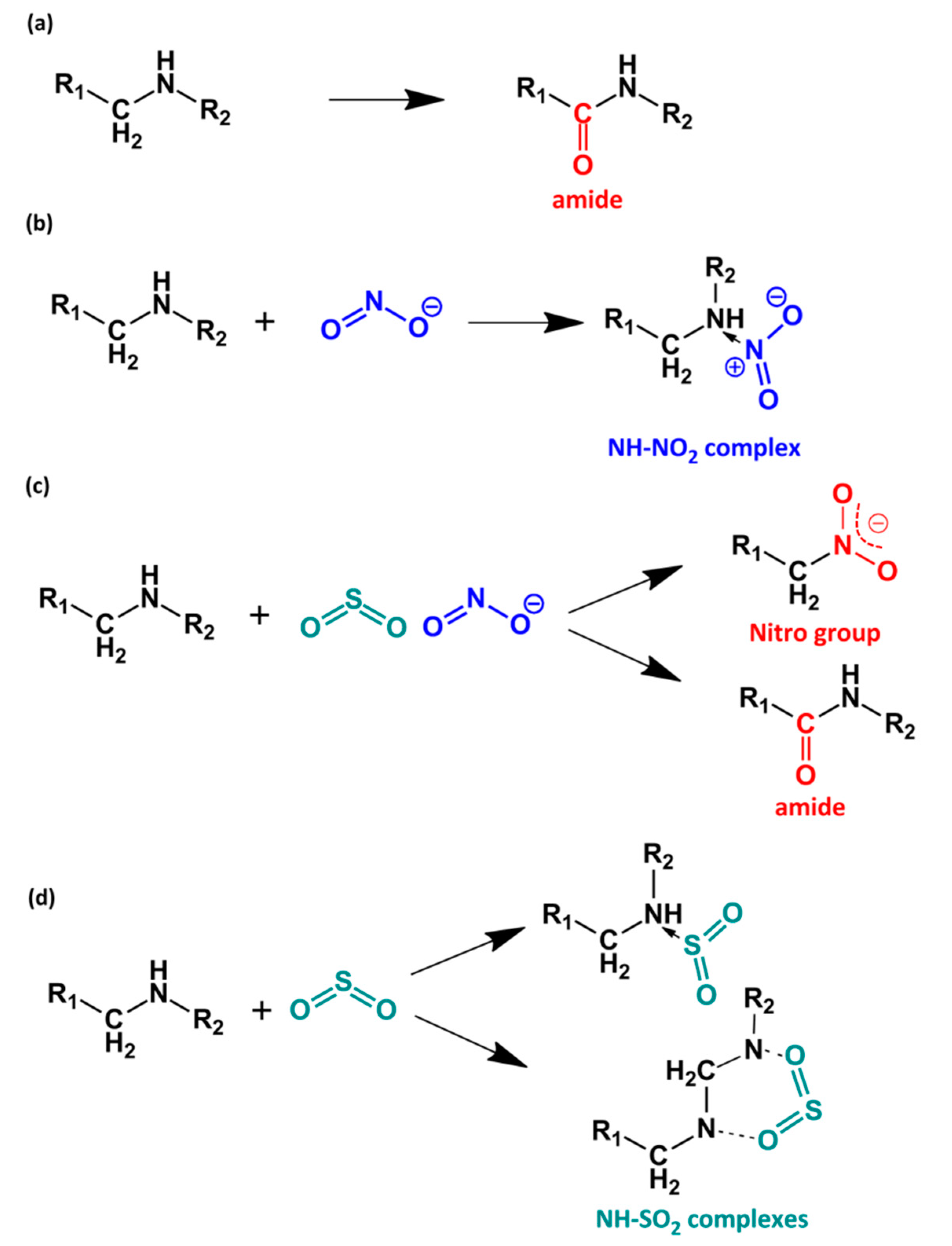
| Sample | Silane Content (mmol/g) | SBET (m2/g) a | Vp (cm3/g) b |
|---|---|---|---|
| Kona95 | - | 253 | 0.765 |
| 2NS/Kona95 | 3.19 | 18 | 0.105 |
| 2NS-P/Kona95 | 2.50 | 23 | 0.114 |
| Adsorbent | Silane Content (mmol/g) | Fresh CO2 Sorp. (wt %) | Exposure at 110 °C | Exposure at 130 °C | Exposure at 150 °C | |||
|---|---|---|---|---|---|---|---|---|
| CO2 Sorp. (wt %) | % Decrease | CO2 Sorp. (wt %) | % Decrease | CO2 sorp. (wt %) | % Decrease | |||
| 2NS/Kona95 | 3.19 | 6.70 | 1.27 | 81 | 0.99 | 85 | 0.87 | 87 |
| 2NS-P/Kona95 | 2.50 | 6.70 | 2.17 | 68 | 1.89 | 72 | 1.74 | 74 |
| Wavenumber (cm−1) | Assignment | Species |
|---|---|---|
| 1705–1700 | C=O stretch | Cyclic urea |
| 1700–1680 | C=O stretch | Carbamic acid |
| 1635–1625 | NH3+ asym. def | NH3+ |
| 1601–1590 | NH deformation | NH2 |
| 1570–1545 | COO− asym. stretch | Carbamate |
| 1565–1560 | C–N stretch | Cyclic urea |
| 1520–1515 | NH deformation C–N stretch | Silylpropyl carbamate |
| 1510 | NH def./ C–N stretch | Carbamate |
| 1550–1485 | NH3+ sym. def. | NH3+ |
| 1500–1495 | C–N stretch | Cyclic urea |
| 1490–1480 | NCOO− vibration | Carbamate |
| 1440–1410 | COO− sym. stretch | Carbamate |
| 1380 | COO− sym. stretch | Carbamate |
| 1320 | NCOO− vibration | Carbamate |
| Material | Structure |
|---|---|
| N-[3-(trimethoxysilyl)propyl]ethylenediamine (2NS) |  |
| (3-Chloropropyl)trimethoxysilane (CPTMS) |  |
| 1,3-Diaminopropane (DAP) |  |
| N1-(3-(trimethoxysilyl)propyl)propane-1,3-diamine (2NS-P) |  |
© 2019 by the authors. Licensee MDPI, Basel, Switzerland. This article is an open access article distributed under the terms and conditions of the Creative Commons Attribution (CC BY) license (http://creativecommons.org/licenses/by/4.0/).
Share and Cite
Pacia, R.M.; Manianglung, C.; Ko, Y.S. In Situ IR Study on Effect of Alkyl Chain Length between Amines on Its Stability against Acidic Gases. Catalysts 2019, 9, 910. https://doi.org/10.3390/catal9110910
Pacia RM, Manianglung C, Ko YS. In Situ IR Study on Effect of Alkyl Chain Length between Amines on Its Stability against Acidic Gases. Catalysts. 2019; 9(11):910. https://doi.org/10.3390/catal9110910
Chicago/Turabian StylePacia, Rose Mardie, Clinton Manianglung, and Young Soo Ko. 2019. "In Situ IR Study on Effect of Alkyl Chain Length between Amines on Its Stability against Acidic Gases" Catalysts 9, no. 11: 910. https://doi.org/10.3390/catal9110910
APA StylePacia, R. M., Manianglung, C., & Ko, Y. S. (2019). In Situ IR Study on Effect of Alkyl Chain Length between Amines on Its Stability against Acidic Gases. Catalysts, 9(11), 910. https://doi.org/10.3390/catal9110910





